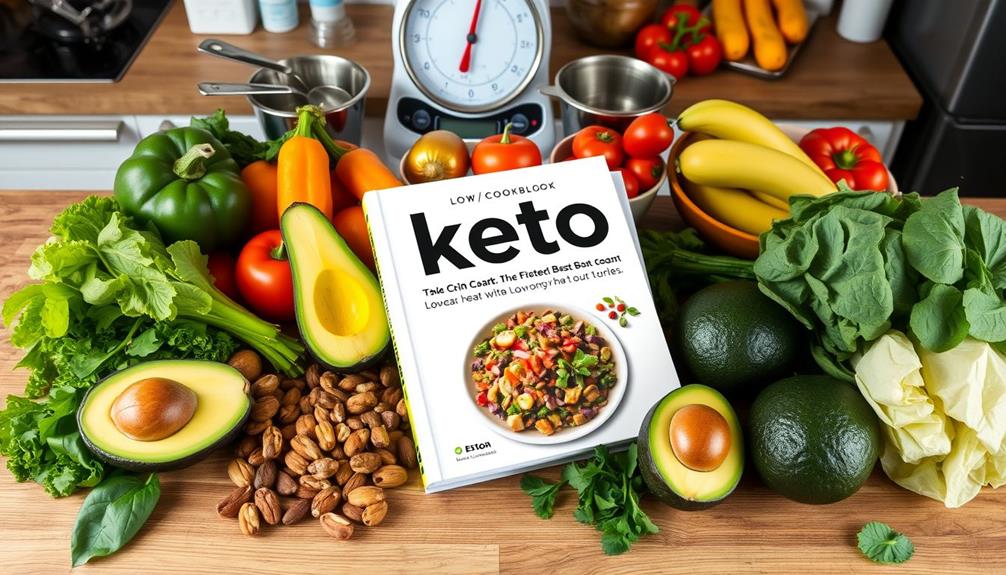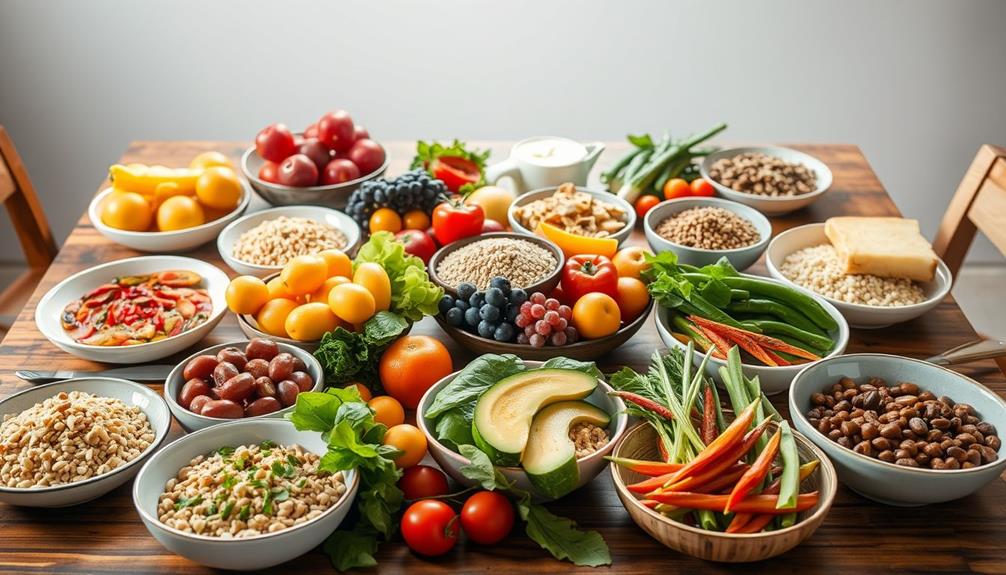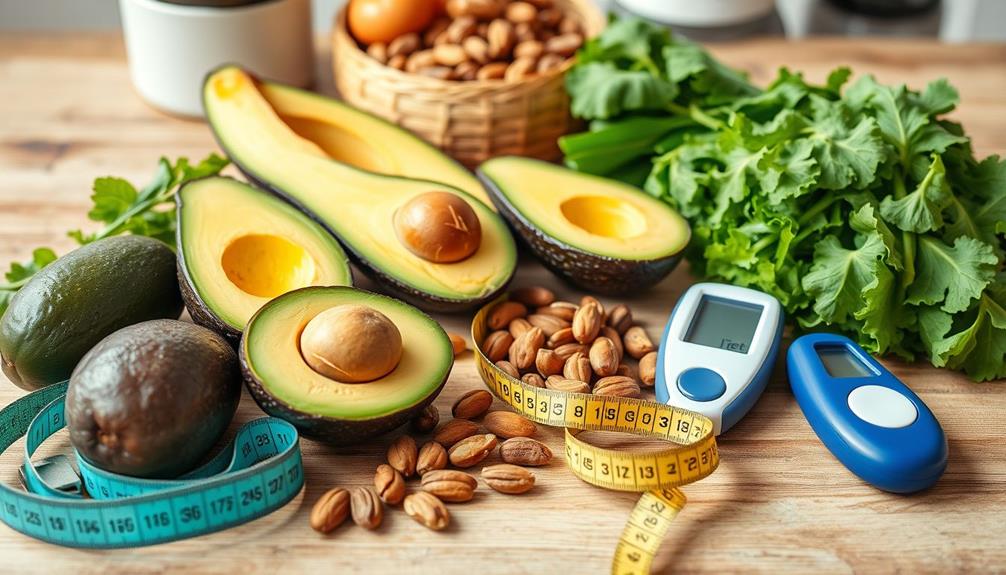To start the keto diet, you'll need to cut your carbs to about 20-50 grams per day. Focus on high-fat foods like avocados, olive oil, nuts, and fatty meats, while avoiding sugar, grains, and starchy veggies. Aim for a macronutrient ratio of 70% fat, 20% protein, and 10% carbs. Meal prep can make this easier—plan your meals and stock up on keto-friendly ingredients. Stay hydrated and keep an eye on your electrolytes to ease any initial side effects. Ready to discover effective strategies for a smooth shift into this lifestyle? There's more to uncover!
Key Takeaways
- Reduce carbohydrate intake to 20-50 grams per day to induce ketosis and promote fat burning for energy.
- Focus on healthy fats like avocados, olive oil, and nuts to meet the 70% fat macronutrient target.
- Plan meals using low-carb vegetables, high-quality proteins, and full-fat dairy to create balanced, keto-friendly dishes.
- Stay hydrated and replenish electrolytes to alleviate potential "keto flu" symptoms during the initial transition.
- Monitor your body's response and consult healthcare professionals for personalized guidance throughout your keto journey.
Understanding the Keto Diet

When it comes to the ketogenic diet, understanding its core principles is essential for success. The keto diet focuses on drastically reducing your carbohydrate intake to between 20 and 50 grams per day. This significant reduction shifts your body's primary energy source from glucose to fat, inducing a metabolic state known as ketosis. In ketosis, your body effectively burns fat for fuel, which can lead to rapid weight loss.
Effective strategies for weight loss can play a significant role in enhancing your keto journey.
A typical macronutrient ratio for the Standard Ketogenic Diet (SKD) consists of about 70% fat, 20% protein, and only 10% carbohydrates. This ratio promotes fat metabolism and enhances ketone production, crucial for maintaining nutritional ketosis.
To achieve and sustain this state, you'll want to consume high-fat foods such as avocados, nuts, oils, and fatty fish while avoiding sugary foods, grains, and most fruits.
Many people starting the keto diet experience quick initial weight loss, thanks not only to fat loss but also due to a significant reduction in water weight from cutting back on carbohydrates.
Essential Foods for Keto

To successfully commence your keto journey, knowing which foods to include in your diet is essential. Focus on high-fat foods that should make up about 70% of your daily caloric intake. Incorporate avocados, olive oil, nuts, seeds, fatty fish, and grass-fed meats to help you achieve effective ketosis. Additionally, including foods rich in antioxidants can support overall health, rich in antioxidants and may enhance your energy levels.
In addition to high-fat foods, don't forget to add low-carb vegetables to your meals. Spinach, broccoli, zucchini, and kale not only provide essential vitamins and minerals but also keep your carbohydrate intake low. Aim to limit your total carbohydrate consumption to below 20-50 grams per day to maintain ketosis.
When it comes to dairy, choose full-fat, unprocessed options like cheese, cream, and yogurt. These can enhance your fat intake without unnecessary carbs.
Be cautious of hidden sugars and carbs lurking in processed foods; always read labels to guarantee you stay within your net carb limits. By focusing on these essential foods, you'll set a strong foundation for your keto diet and make your shift smoother.
Foods to Avoid on Keto

Adopting a keto diet means being mindful of what you can't eat as much as what you can. To maintain your state of ketosis, you'll need to focus on reducing your carb consumption greatly. Incorporating strategies like essential oils for relaxation can help ease the shift to this new eating plan.
Here's a list of key foods to avoid on keto:
- Sugary foods like candy, soda, and fruit juices
- Grains such as wheat, rice, pasta, and bread
- Most fruits, except for small portions of berries
- Starchy vegetables like potatoes, corn, and carrots
- Processed foods with hidden sugars and refined carbs
These foods are high in carbs and can quickly exceed your carbohydrate limit. Sugary items can spike your blood sugar levels, while grains and starchy vegetables can disrupt ketosis altogether.
Most fruits, despite their health benefits, contain too much sugar to be included in your diet. It's vital to steer clear of processed foods as they often contain unexpected sugars that can derail your keto goals.
Meal Planning Strategies

When you're planning your meals on a keto diet, focus on including essential foods like healthy fats, high-quality proteins, and low-carb veggies.
Incorporating a balanced diet rich in these components is important for maintaining ketosis and overall health. Use meal prep techniques, such as batch cooking, to make sticking to your plan easier during busy days.
Additionally, monitoring macronutrient intake is essential to guarantee you're achieving the right balance.
Don't forget to take into account keto-friendly snacks that can help keep your energy up without derailing your progress.
Essential Foods to Include
Embracing the essence of the keto diet involves selecting the right foods to guarantee your meals stay satisfying and aligned with your goals. Prioritizing high-fat foods, low-carb vegetables, and protein sources is essential to maintain your macronutrient balance. Aim for approximately 70% of your daily calories from fats, 20% from proteins, and 5-10% from carbs.
Additionally, understanding the importance of cold medications overview can help in managing any cold symptoms that may arise during your dietary changes.
Here are some essential foods to include in your meal planning:
- Avocados: Rich in healthy fats and fiber.
- Nuts and seeds: Great for snacking and adding crunch.
- Olive oil: Perfect for dressings and cooking.
- Fatty fish: Salmon and mackerel provide omega-3s.
- Low-carb vegetables: Spinach, kale, broccoli, and zucchini are nutrient-dense options.
Stock up on protein sources like eggs, grass-fed meats, and unprocessed cheeses to fulfill your protein needs.
When planning meals, create simple recipes that combine these food groups, like salads with fatty dressings or meat dishes paired with low-carb veggie sides.
Meal Prep Techniques
Meal prep techniques can transform your keto journey by making it easier to stick to your dietary goals. Start by determining your daily macronutrient targets, aiming for a ratio of about 70% fat, 20% protein, and 10% carbs. This will help you effectively induce ketosis.
Stock your kitchen with keto-friendly staples like olive oil, avocado oil, low-carb vegetables such as spinach and broccoli, and quality protein sources like fatty fish and eggs. Consider incorporating innovative coffee gear to enhance your coffee experience while on keto, as some coffee beverages can fit within your carb limits.
Plan 1-2 breakfast options, one lunch, and two dinner recipes for the week. This approach allows for easy repetition and minimizes the effort needed on busy days.
Batch cooking is a game changer—make soups, casseroles, or stir-fries in large quantities to save time while ensuring you have keto-friendly meals ready to go.
Consider using meal prep containers to store pre-portioned servings. This not only keeps your meals organized but also makes it easier to grab something on the go while keeping your carb intake in check.
With these meal prep techniques, you'll find sticking to your keto diet is more manageable and enjoyable.
Snacking on Keto
Snacking on keto can be both satisfying and simple when you focus on high-fat, low-carb options. To stay within the ketogenic macronutrient guidelines, choose snacks that will curb your hunger without derailing your progress.
Additionally, understanding your budget when purchasing keto-friendly snacks can help you avoid overspending on unhealthy options. Here are some great ideas for snacking on keto:
- Avocados: Creamy and rich, perfect for a quick bite.
- Nuts: Almonds, macadamias, or walnuts offer a crunchy treat.
- Cheese: String cheese or cheese crisps are convenient and delicious.
- Hard-boiled eggs: Packed with protein and healthy fats.
- Low-carb veggies: Pair celery or cucumber with guacamole or ranch dressing.
Consider preparing your high-fat snacks in advance. Homemade cheese crisps or nut butter fat bombs can be lifesavers when cravings hit.
Portion control is essential; pre-pack snacks into small containers to stay mindful of your fat intake. If you're on the go, keto bars or shakes can be handy, but always check the labels for hidden sugars and net carb counts.
Managing Keto Side Effects

Starting the ketogenic diet can come with its fair share of challenges, often referred to as the "keto flu." To manage these side effects effectively, it's crucial to focus on hydration and electrolyte balance. As your body shifts into ketosis, it tends to excrete more water and electrolytes, which can lead to symptoms like fatigue and headaches. Increasing your sodium and potassium intake can help alleviate these issues.
Additionally, understanding the importance of advance care planning can be beneficial, particularly for individuals managing chronic conditions and considering their long-term health needs. financial considerations for elderly care might also play a role in maintaining a healthy lifestyle.
You might also consider gradually easing into the ketogenic diet over a week. This approach allows your body to adjust to reduced carbohydrate intake without overwhelming it. Moreover, incorporating high-fiber, low-carb vegetables can assist in alleviating digestive concerns, such as constipation, that might arise.
Engaging in light physical activity, such as walking or yoga, can also boost your energy levels and help combat feelings of lethargy during the initial adaptation period. If you continue to experience persistent side effects, don't hesitate to consult a healthcare provider. They can help tailor your diet to your individual needs and guarantee you're meeting all your nutritional requirements while on keto.
Importance of Hydration

Here are some tips to guarantee you're staying hydrated:
– Drink water consistently throughout the day, not just when you're thirsty. Staying hydrated is vital for maintaining overall health, just as creating a personal budget is essential for managing your finances effectively.
You can learn more about budgeting strategies here.
- Consider incorporating broth to replenish electrolytes like sodium and potassium.
- Monitor your urine color; a light yellow indicates proper hydration.
- Keep a water bottle with you to track your intake easily.
- Adjust your hydration based on activity levels and environmental conditions.
Electrolyte Balance on Keto

Staying hydrated is just the beginning when you commence on the keto diet; maintaining your electrolyte balance is equally important. During the initial phase, your body excretes more water and electrolytes due to reduced insulin levels, which heightens the need for adequate sodium, potassium, and magnesium intake.
Incorporating essential oils, such as eucalyptus oil for respiratory health, can also support your overall wellness during this change. If you don't manage your electrolyte intake, you might experience symptoms of electrolyte imbalance, often known as "keto flu." These can include fatigue, muscle cramps, headaches, and dizziness.
To guarantee proper hydration and electrolyte balance, aim for 6-8 glasses of water daily. Incorporate electrolyte-rich foods into your meals, such as avocados, leafy greens, nuts, and bone broth.
Adding a pinch of salt to your food or drinking electrolyte-enhanced beverages can help replenish sodium levels, vital for nerve function and muscle contraction during ketosis.
It's also important to monitor and adjust your electrolyte intake based on your individual needs, especially during the first few weeks of starting the keto diet. This proactive approach will help you navigate smoothly and prevent discomfort as your body adapts to its new fuel source.
Assessing Your Suitability for Keto

Before you jump into the keto diet, it's essential to assess your personal health and any dietary restrictions you might have.
Consider any ongoing health issues, as certain conditions may require specific dietary adjustments, similar to how newborn constipation can affect an infant's comfort based on their diet.
Think about whether this low-carb, high-fat lifestyle fits into your long-term habits and preferences.
Understanding these factors will help you determine if keto is the right choice for you.
Personal Health Considerations
A thorough assessment of your personal health is essential when considering the ketogenic diet. Before diving in, it's vital to consult with a healthcare provider, especially if you have pre-existing conditions like diabetes, liver disease, or kidney issues. This step guarantees keto is a safe choice for you and helps tailor the diet to fit your needs.
Additionally, understanding the potential risks and rewards of Bitcoin IRAs can help you make informed decisions about your financial health, similar to how you should approach your dietary choices.
Consider the following points:
- Evaluate your lifestyle and dietary preferences; strict carb limits may not suit an active lifestyle.
- Think about your long-term adherence to the diet; its restrictive nature might hinder sustainable weight loss.
- Monitor your body's response during the initial phase; symptoms like fatigue or headaches may indicate how well you're adapting.
- Assess any medications you're taking, particularly insulin or blood sugar-lowering drugs, as keto can considerably impact blood glucose levels.
- Be prepared for potential dosage adjustments of medications under your healthcare provider's guidance.
Taking these personal health considerations into account will help you make an informed decision about starting the ketogenic diet, ensuring it aligns with your health goals and lifestyle.
Dietary Restrictions Analysis
After considering your personal health and consulting with a healthcare provider, it's time to analyze your dietary restrictions to determine if the ketogenic diet is suitable for you.
Start by evaluating any pre-existing health conditions, like diabetes or heart disease, since the keto diet can notably affect blood sugar and cholesterol levels. It's essential to recognize that individuals with certain health concerns may require additional monitoring, similar to how mammography guidelines suggest personalized approaches based on individual risk factors.
If you're on medications, particularly insulin or blood sugar-lowering agents, it's vital to consult with a healthcare provider to avoid complications during your shift to ketosis.
Next, evaluate your personal dietary restrictions, such as allergies or intolerances, which could limit your food choices on a high-fat, low-carb diet. This requires careful planning to guarantee you meet your nutritional needs.
Consider your lifestyle and eating preferences, too; the strict carb limits of keto can be tough if you enjoy a diverse range of foods, especially fruits and grains.
Long-term Lifestyle Compatibility
Determining your long-term compatibility with the ketogenic diet hinges on a realistic assessment of your health, lifestyle, and dietary preferences.
It's crucial to take into account whether you can sustain a low-carb, high-fat diet while achieving long-term weight loss and health benefits. Here are some factors to evaluate:
- Assess your current health status and any medical conditions that may affect your ability to follow keto.
- Reflect on your daily routine to guarantee you can consistently adhere to the diet.
- Identify potential challenges, such as social situations where high-carb foods are prevalent.
- Monitor your body's response during the initial shift to ketosis, including any symptoms of "keto flu."
- Consult with healthcare professionals or nutritionists to personalize the keto diet for your unique needs.
Short-Term Vs Long-Term Keto

The ketogenic diet's appeal often lies in its ability to deliver quick weight loss results, making it a popular choice for those looking to shed pounds rapidly. Many people experience impressive short-term weight loss, often losing more weight than those on balanced diets within the first few months.
Additionally, you might enjoy benefits like improved blood sugar control and increased energy levels, especially if you're managing type 2 diabetes.
However, while the ketogenic diet can kickstart your weight loss journey, long-term adherence can be challenging. You could face potential nutrient deficiencies and health risks associated with a high intake of animal products, which might increase your risk of heart disease.
Experts generally recommend viewing the keto diet as a temporary strategy rather than a permanent lifestyle. Once you reach your initial weight loss goals, shifting to a more balanced diet may be a healthier option.
Though the keto diet can provide immediate results, ongoing research is essential to fully understand its long-term health effects and sustainability for different populations.
Ultimately, it's vital to evaluate the balance between short-term gains and long-term health.
Transitioning Off the Keto Diet

Switching off the keto diet can be a delicate process, but with careful planning, you can make it smooth and effective.
Start by gradually reintroducing carbs into your diet. Instead of diving into high-carb foods, opt for small portions of whole grains, fruits, and starchy vegetables to ease your body back into a more balanced state.
Here are some tips to guide you through moving away from the keto diet:
- Increase your carb intake by 10-20 grams per week, monitoring how your body responds.
- Choose nutrient-dense carbs like whole grains, legumes, and non-starchy vegetables.
- Keep your protein and healthy fat intake adequate to maintain muscle mass and overall health.
- Stay hydrated, and consider replenishing electrolytes as your fluid balance changes.
- Listen to your body; adjust portions and types of foods based on your energy levels and cravings.
Frequently Asked Questions
How Do I Start My Keto Diet for the First Time?
To start your keto diet, calculate your macronutrient ratio, stock up on high-fat, low-carb foods, and gradually reduce carbs. Plan meals, stay hydrated, and maintain your electrolytes to ease into this new lifestyle. If you’re new to the keto diet, it may be helpful to seek out a beginner’s guide to keto diet to fully understand the principles and best practices. It’s important to monitor your progress and make adjustments as needed, especially in the first few weeks as your body adapts to burning fats for fuel. By following a beginner’s guide to keto diet, you can ensure that you’re on the right track and set yourself up for success on this new journey towards better health and wellness.
What Is a Keto Diet Plan for Beginners?
A keto diet plan for beginners focuses on high-fat foods, low carbs, and meal prepping. You'll track your carb intake, prioritize hydration, and manage electrolytes to ease into ketosis and avoid the "keto flu."
What Are the 9 Rules of Keto?
When following keto, you should limit carbs to 20-50 grams daily, focus on high fat, choose whole foods, stay hydrated, maintain electrolytes, and adjust your macros based on how your body responds.
How Do Beginners Get Into Ketosis?
To get into ketosis, drastically cut carbs to 20-50 grams daily, boost healthy fats to 70-80% of your diet, and maintain moderate protein intake. Stay hydrated, balance electrolytes, and stay active to aid this shift.
Conclusion
Embracing the keto diet can transform your health, fuel your energy, and sharpen your focus. By understanding essential foods, avoiding pitfalls, and planning meals wisely, you set yourself up for success. You're not just changing what you eat; you're reshaping your lifestyle. As you navigate the ups and downs, remember to listen to your body and adjust as needed. Whether it's a short stint or a long commitment, keto can reveal a new you.









